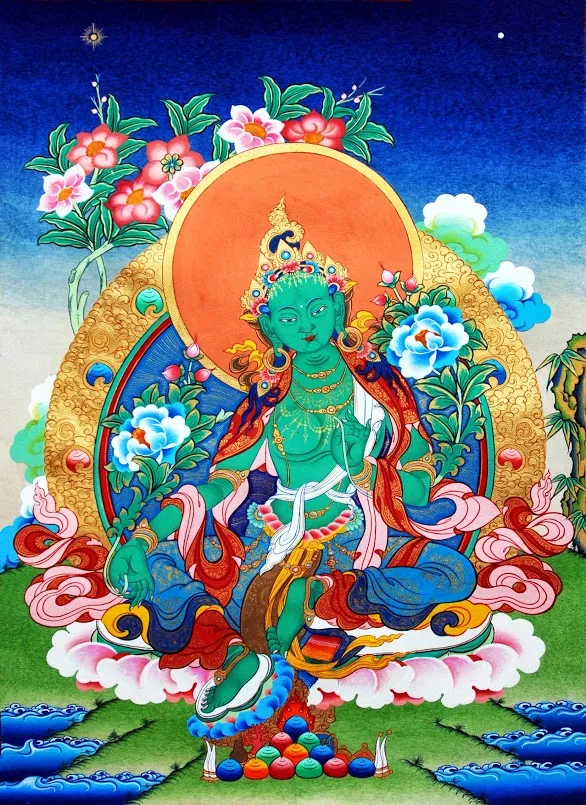Group Practices
Learning about and engaging in various traditional practices.
The ordinary view is that reality is "out there" and that it "has nothing to do with me."
The Buddhist view is that things arise due to causes and conditions, particularly
karmic causes — from the imprints created by our own actions — and from the process of mental imputation.
That's good news; that means we can change reality. However, we have to do some karmic action to make it happen.
And we have to work on our own minds.
That's why we do these practices which have been handed down to us by a long lineage of realized masters from centuries past.
Puja
Puja is a Sanskrit word which means offering. A puja is a ritual that generally involves:
-
chanting — verses of praise, reviewing the points of the path, and so forth, and
-
making offerings — both actual and imagined.
Everyone is welcome to come to these pujas and join in. It is very beneficial for the energy of the Dharma center and for the individuals who participate. When people travel to India, Nepal, or in some cases Tibet, where they have a chance to visit a Tibetan monastery or nunnery, they are often struck by the power of the chanting with a hall full of monks or nuns. We don't have a lot of monks and nuns, but we can still get together and create some powerful energy.
Why do pujas?
Performing pujas and sutra recitations creates merit and purifies obstacles for:
-
the Dharma center
-
the people who are doing the recitation
-
the whole community, and
-
the whole world
Why Medicine Buddha and Tara pujas?
Years ago, Lama Zopa Rinpoche recommended these two pujas to our group (and to the FPMT centers in general) because they each cover so many situations.
Each of the twenty-one Taras and each of the seven Medicine Buddhas addresses specific types of problems and brings specific types of success, which taken all together cover just about everything we could want.
-
Who is Tara?
Tsog — rhymes with choke
Tsog is generally performed on the lunar 10th and 25th.
See Tibetan calendar at: https://fpmt.org/media/resources/dharma-dates/
When a Sunday falls on or near one of the lunar dates for offering tsog, we will perform the Tsog with the Guru Puja.
If you have taken a Highest Yoga Tantra empowerment, then you should probably come to this, unless you are already going to one at another Dharma center.
(Note: both Guru Puja and Tsog can also be practiced separately; e.g., some people do Guru Puja as a daily practice.)
When coming to a tsog, bring a food offering to share.
This is usually a snack item that can be easily passed out.
(We have a request from some participants to consider bringing more healthful offerings, perhaps nuts, crackers, fruit.)

Sadhanas
Sadhana is a Sanskrit word that means something like 'practice' or as the Tibetans say, 'means of achievement.' A sadhana is similar to a puja but can include more meditation, visualization, and mantra recitation. In general, the sadhanas that we do at the center are open to everyone, not requiring any empowerment. Often there are alternate ways of visualizing based on whether you have the empowerment for that practice or not.
Sutra and Shastra Recitations
Approximately once a month, we recite a sutra or shastra.
Reciting means reading aloud.
Sutra = the canonical teachings of the Buddha.
Examples of sutras that we would recite are:
-
Diamond Cutter Sutra
-
Perfection of Wisdom Sutra in 8,000 lines
-
Sutra of Golden Light
-
Arya Sanghata Sutra
-
Gandavyuha, i.e., The King of Prayers
These are all Mahayana Sutras from the Sanskrit Canon.
Shastras are the commentaries by the great scholar-saints of ancient times such as:
-
The Precious Garland by Nagarjuna
-
A Guide to the Bodhisattva Way of Life by Shantideva
As with the pujas, you are all very welcome to join in these recitations.